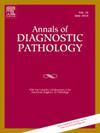Clinicopathological features analysis of Paraganglioma of urinary bladder: A retrospective study
IF 1.4
4区 医学
Q3 PATHOLOGY
引用次数: 0
Abstract
Paraganglioma of urinary bladder (PUB) is a rare neuroendocrine neoplasm. This study is a retrospective analysis of clinicopathological features in 11 cases of PUB. The studied cohort included seven male and four female patients with a median age of 64 years (range 37–73 years). The maximum tumor diameter ranged from 1 to 4 cm (median: 2.5 cm). Macroscopically, most lesions appeared as smooth, polypoid intraluminal protrusions; one case exhibited a nodular mass extending into the outer bladder wall. Microscopic evaluation demonstrated tumor infiltration into the muscularis propria (6 cases) or both lamina propria and muscularis propria (5 cases). Tumor cells were arranged in nested (Zellballen) or organoid patterns. Tumor cells uniformly expressed CD56, synaptophysin, and chromogranin. The Ki-67 proliferation index was ≤8 % in 10 cases; one case with a 4 cm tumor demonstrated a higher Ki-67 index (20 %), correlating with infiltrative growth and increased mitotic activity. Among the 10 cases that were evaluated, 2 (20 %) showed a loss of SDHB expression; Eight (80 %) of 10 cases were GATA3-positive, and all cases were negative for OCT3/4. Nine (81.8 %) underwent transurethral resection of bladder tumor, and 2 (18.2 %) underwent partial cystectomy. Intraoperative blood pressure fluctuations were observed in 2 patients (18.2 %). The median follow-up time was 26 months (range 4–73 months); one patient experienced a recurrence of endometrial cancer 4 years later and was lost to follow-up at 73 months; the remaining 10 patients survived without recurrence or metastasis. Improved preoperative recognition of PUBs relies on integrating clinical, biochemical, and imaging findings. Standardized immunohistochemical panels may enhance diagnostic accuracy.
膀胱副神经节瘤临床病理特征分析:回顾性研究
摘要膀胱副神经节瘤是一种罕见的神经内分泌肿瘤。本文对11例PUB的临床病理特征进行回顾性分析。研究队列包括7名男性和4名女性患者,中位年龄为64岁(37-73岁)。最大肿瘤直径1 ~ 4cm(中位2.5 cm)。宏观上,大多数病变表现为光滑的息肉样腔内突出;1例表现为结节性肿块延伸至膀胱外壁。显微镜检查显示肿瘤浸润到固有肌层(6例)或同时浸润到固有层和固有肌层(5例)。肿瘤细胞呈巢状排列或类器官排列。肿瘤细胞一致表达CD56、synaptophysin和chromogranin。10例Ki-67增殖指数≤8%;1例4cm肿瘤的Ki-67指数较高(20%),与浸润性生长和有丝分裂活性增加有关。在10例被评估的病例中,2例(20%)表现为SDHB表达缺失;10例患者中gata3阳性8例(80%),OCT3/4均阴性。经尿道膀胱肿瘤切除术9例(81.8%),膀胱部分切除术2例(18.2%)。术中出现血压波动2例(18.2%)。中位随访时间为26个月(范围4-73个月);1例患者4年后子宫内膜癌复发,73个月后失去随访;其余10例患者存活,无复发或转移。提高术前对小酒馆的识别依赖于综合临床、生化和影像学表现。标准化的免疫组织化学检查可以提高诊断的准确性。
本文章由计算机程序翻译,如有差异,请以英文原文为准。
求助全文
约1分钟内获得全文
求助全文
来源期刊
CiteScore
3.90
自引率
5.00%
发文量
149
审稿时长
26 days
期刊介绍:
A peer-reviewed journal devoted to the publication of articles dealing with traditional morphologic studies using standard diagnostic techniques and stressing clinicopathological correlations and scientific observation of relevance to the daily practice of pathology. Special features include pathologic-radiologic correlations and pathologic-cytologic correlations.

 求助内容:
求助内容: 应助结果提醒方式:
应助结果提醒方式:


